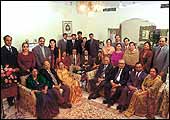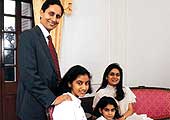|
The
growing impact of urbanisation, secularisation, and westernisation
has wreaked havoc on the traditional joint family. Once, three or
four patrilineally-related generations, all lived under one roof
(some still do), working, eating, worshipping, and cooperating.
The transition to the nuclear family has been an extremely complex
and difficult process. It is never easy to break the existing lines
of hierarchy and authority without pain and angst.
 |
| The Munjal family: Even in this frenetic
age three generations of the family share close personal ties |
Yet sociologists
believe that the splintering of joint families does not necessarily
represent the rejection of the joint-family ideal. "The establishment
of a new home does not mean the severance of ties with kin groups
of the husband and wife,'' notes sociologist M.N. Srinivasan in
his book India: Social Structure. The nuclear family has often been
the response, he says, to a variety of conditions, including the
need for some members to move from village to city, or from one
city to another to take advantage of employment opportunities.
Two rituals that have become quite popular
with Hindus embody the new family, notes Vinay Kumar Srivastava,
an anthropologist from Delhi University. One is fasting for the
longevity of the husband. The other is the worship of Lakshmi and
other gods of material prosperity. ''The popularity of the first
indicates the importance that conjugal relationships have gained
in a nuclear household, which were not so in a traditional joint
family,'' says Srivastava. ''Second, wealth has come to occupy the
centrestage of life.''
 |
| G.K. Birla and family: One of new generation
of Birlas. The extended family exists, but in the background |
The birth of the nuclear families has removed,
to a large extent, the stresses and strains of day-to-day living
between the different units of family, especially the celebrated
mother-in-law and daughter-in-law conflicts, or fights between the
wife and her husband's sisters, and between her and her husband's
brothers' wives. What it's also inadvertently done is to allow many
women to explore their potential in the workforce, though they inevitably
have to balance their professional lives with responsibilities at
home. The needs and ambitions of the nuclear family also imply that
women have to work to maintain the family's standard of living.
Driven by the explosion of jobs in media, telecommunication,
finance, and marketing, India has also seen the birth of the urban
singleton, the professional man or woman who has created a solitary
life divorced from every traditional norm of the Indian family.
Some adapt, others don't. Even at the lower rungs of the income
ladder, droves of young men looking for jobs and a better tomorrow
have left the safety net of community and family and travelled to
the city, often alone and isolated.
But habits, and family, don't vanish overnight.
Even in this frenetic age, members of the joint family come together
during the propitiation of dead ancestors or during important family
functions like marriages, worship of family deities, the birth of
a child, the donning of the sacred thread-there are many such factors
that act as an adhesive to the family, even in this, the age of
leaving your family.
-Ashish Gupta
The Great Divide
 |
| Deep Fissures: A unified national polity
remains elusve still |
Barely six months
ago, August 8, 2001, to be precise, two young lovers were hanged
to death from the roof of a house in Uttar Pradesh by their own
family members in front of hundreds of onlookers. They had committed
the cardinal sin of falling in love despite belonging to two different
castes. While the boy, Vishal, was a high-caste Brahmin, the girl
came from the much lower Jat community. That's just another horrific
example of the stranglehold that the ubiquitous caste system has
over large swathes of Indian society.
In a society so strongly driven by differences
of caste, religion, language, gender, ethnicity, occupation as well
as the north-south divide and a multiple of other factors, it would
be a complete fallacy to talk about a single great divide. There
is of course the most obvious one-the rich-poor divide propounded
and perpetuated by many left-leaning scholars-but that's just one.
You can easily see the diversity in India's social system in the
patterns of rural as well as urban settlements, and well, in simple
daily life. Nowhere else in the world do modern malls have cows
grazing in the parking lot. Nowhere else in the world will you find
bullock carts going the wrong way on expressways. In kinship, marriage
rites and customs, inheritance, and the general mode of living,
there appear to be sometimes unbridgable gaps between various kinds
of Indians. There is perhaps no other society on earth that boasts
of so many divisions. There is also perhaps no other society on
earth that somehow pulls together despite these divisions.
The foundation of the modern Indian divide
is the existence of ancient fissures in a contemporary setting.
For instance, most sociologists maintain that the existence of a
high degree of congruence between caste and agricultural hierarchy
enabled the landholders to exploit the tenants as much as they could-rack
renting, eviction and forced labour were, and still are, usual features
of rural life. But the system wasn't as brutally split then as it
is now. ''Even in traditional Indian society there was a system
of gradations in caste rather than a bipolar system,'' says Andre
Beteille, former professor of sociology, Delhi School of Economics,
University of Delhi.
Most upsetting to social observers is the fact
that even after 50 years of Independence, the Indian political system
has failed to create a unified national political identity, which
could, if not submerge, manage the divisive bonds of religion, caste,
region, language and ethnicity. If anything, the self of identity
that a maturing democracy gains is giving new life to old divisions
and creating fresh ones. The north-south divide, which rears its
ugly head from time to time, is a simmering, sub-surface phenomenon
that never really dies. Linguistic divisions between states have
in the last two decades increasingly threatened to become flashpoints.
As northerners become distinctly strident about their identity,
many southerners see themselves as guardians of a distinct sub-identity
within the national fabric. The uniqueness of this identity is best
exemplified by the fact that the nation's largest political party
is a non-starter in the south, and the second-largest is fast approaching
that status. And of course there is the east, and the north-east...
Like an onion, the great Indian divide is multilayered.
The poor and the rich present a ubiquitous starkness to life that
is so much typically Indian. But beyond that, there are the divisions
of 1,500 dialects, 18 officially-recognised languages and several
religious communities including Hindus, Muslims, Christians, Sikhs,
Buddhists, Jains, and Parsis. India can only be a land of composite
culture, a loose unity in diversity, it can never-ever-have a single
great divide. The layers of onion will only grow, and multiply.
-Ashish Gupta
|

